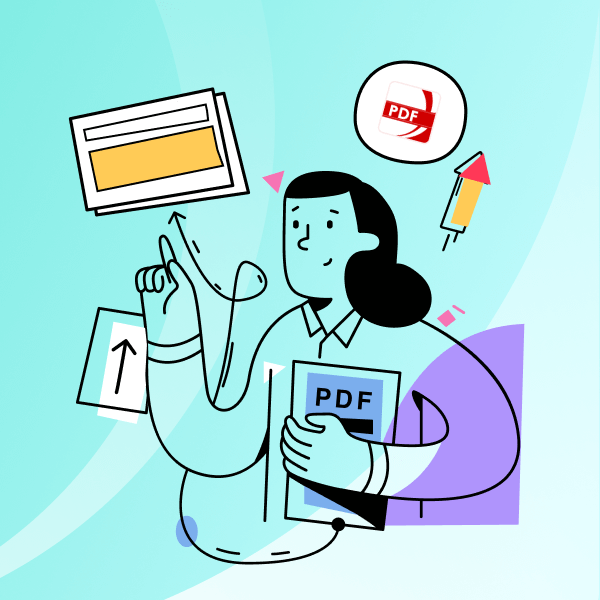Think back to the last thing you bought, whether you clicked 'buy' on a website or handed over cash at a store. Right after you pay, you get a receipt.
Maybe you just chucked that receipt in your bag and forgot all about it. Or perhaps you were more careful, tucking it away in a special folder in your email, just in case you needed it later.
But here's a fun fact: that little piece of paper or digital note you didn't think much about? It's actually a basic form of a bill of sale.
What is a Bill of Sale?
A bill of sale is essentially a document that officially passes the ownership of an item from one person to another. It may sound fancy, but it's similar to a receipt.
It's a piece of paper (or a digital document) that confirms a sale has taken place.
You'll often see bills of sale used for big-ticket items, especially things that get you from point A to point B like cars, motorcycles, or boats.
But really, you can use a bill of sale to transfer ownership of any substantial item. This could be a piece of heavy machinery your company no longer uses or even some old furniture you remove during an office revamp.
When you're parting with something significant, your bill of sale will typically list some essential details, including:
- The seller's name and how to contact them
- The buyer's name and how to contact them
- A description of the item(s) being sold
- The selling price of the item(s)
- The date when the sale happened
- A spot for both the buyer and seller to sign off
Despite the official-sounding name, a bill of sale isn't complicated. It's really just a brief document that shows ownership of an item has changed hands.
Check out our New Mexico Bill of Sale PDF template to streamline your sales transactions.
How to Write a Bill of Sale
Securing a successful transaction, especially when it involves sizable items, goes beyond simple verbal agreements. A meticulously drafted bill of sale is not just a formality; it's a crucial document ensuring transparency and legality.
If the thought of drafting one seems overwhelming, don't worry. You're not alone, and there's help available. Many accessible resources provide a great starting point, including the highly recommended "Bill of Sale PDF Template" from PDF Reader Pro.
Embarking on creating your bill of sale is less complicated when you follow these six key steps:
-
Determine What’s Being Sold: The specifics in your bill of sale are heavily influenced by the type of item. Whether it’s a car or electronic devices, each requires unique details. When dealing with numerous items, delineate each one with its price. Items with varied payment conditions or specific details like liens should be documented on individual bills of sale for clarity.
-
Understand Local Legalities: The stipulations for a bill of sale can vary greatly depending on your location and the nature of the item sold. Conduct thorough research online with a format like "[your location] [item you’re selling] bill of sale" to grasp the nuances of your local requirements. Ensure your sources are credible, like official government websites.
-
Document Both Parties' Details: It's imperative to include comprehensive information about both the seller and the buyer. This includes full names, addresses, and ways to contact each party. Adding identification numbers like driver's licenses can enhance the document's reliability, although it's not mandatory.
-
In-depth Description of the Item: What sets a bill of sale apart from a standard receipt is the detail in the item description. For vehicles, this encompasses specifics like the year, make, model, VIN, and mileage. For other equipment, it's crucial to list details such as make, year, and serial number. The more detailed, the clearer the agreement.
-
Detail the Financials: The heart of the transaction—the financial terms—should be clear and concise in your bill of sale:
- Item's selling price
- Payment terms (lump sum or installments)
- Method of payment (e.g., cash, check, credit card) Such clarity is essential, especially if there's an installment payment plan involved.
-
Space for Official Signatures: The transaction becomes binding once both parties sign and date the bill of sale. Ensure the document concludes with a designated section for both the buyer's and seller's signatures.
While these steps provide a comprehensive framework for your bill of sale, remember, the specifics might vary based on the transaction's nature. Regardless, crafting a bill of sale can be a manageable and secure process with resources like the PDF Reader Pro's template and these guidelines.
Explore our North Carolina Bill of Sale PDF template to facilitate your buying or selling process.

Bill of Sale Example
The look of your bill of sale largely depends on what exactly you're selling, as this dictates the details you'll need to include.
For instance, selling a vehicle would require specifics like the make, model, year, vehicle identification number (VIN), and the current odometer reading.
On the other hand, if you're selling a piece of equipment, you might list things like the model, year, and serial number.
But to give you a basic idea, here's a simple bill of sale example:
Bill of Sale
Seller’s Name: Jane Doe
Seller’s Address: 4567 Liberty Lane, Harmony, TX 75001
Seller’s Contact Information: jane.doe@email.com, 555-321-0987
Buyer’s Name: John Smith
Buyer’s Address: 3210 Peaceful Drive, Harmony, TX 75001
Buyer’s Contact Information: john.smith@email.com, 555-987-6543
Date of Sale: January 19th, 2023
The Seller hereby agrees to sell and transfer ownership of the following item:
- Item Description: 2015 Honda Accord EX-L, 95,000 miles
- Sale Price: $15,000 USD, paid in full with a bank transfer.
Seller’s Signature: _______________________________ Date: _______
Buyer’s Signature: _______________________________ Date: _______
Simple, right? A straightforward bill of sale like this usually doesn't need more than a page unless there are a bunch of extra details you need to include about the item you're selling.
Take a look at our Bill of Sale Oklahoma PDF template to simplify your transaction documentation.
Bill of Sale vs Sales Receipt
While a bill of sale and a sales receipt share similarities and a receipt can indeed be considered a form of bill of sale, they're not exactly the same.
The key difference lies in the level of detail. A bill of sale typically provides comprehensive information about the sold item, covering aspects that go beyond basic identification. On the other hand, a receipt might only offer a brief description or name of the item.
When you delve deeper into the realm of bills of sale, you'll encounter two specific types: absolute and conditional.
According to Cornell Law School, here's a straightforward breakdown:
- Absolute Bill of Sale: This type is utilized when an item is sold "as is" and payment is made in full. Imagine a scenario where a buyer pays cash upfront for a vehicle.
- In such cases, an absolute bill of sale is the go-to document.
- Conditional Bill of Sale: This variant comes into play when certain conditions are attached to the buyer's ownership.
- For instance, you might use a conditional bill of sale if you require the buyer to inform you if they intend to resell the item.
Typically, an absolute bill of sale is the standard choice for straightforward transactions where you're looking to sell an item and conclude the deal.
However, it's crucial to assess your specific situation and choose the type of bill of sale that best aligns with your needs, ensuring a smooth process and avoiding potential complications in the future.
3 Reasons for Creating a Bill of Sale
Deciding to draft a bill of sale during a significant transaction isn't just about ticking a box in the sales protocol.
#FlashbackFriday to 1924, when Alexander Duie Pyle kicked off his dream of starting his own transportation business by purchasing a single truck. 🚚
Check out the Bill of Sale below 👇#ADuiePyle #RoadTo100 pic.twitter.com/ItYVSoRsMl
— A. Duie Pyle (@ADuiePyle) January 19, 2024
It's a strategic move that brings a multitude of benefits, making it well worth the effort:
-
Establishing Concrete Proof: When parting with a valuable item, it's crucial to have undeniable evidence marking the change of hands. This document serves as a written testament to the transaction, offering both the seller and the buyer a concrete record of ownership transfer. This not only ensures transparency but also fosters trust between the two parties.
-
Complying with Legal Standards: Local laws often mandate a bill of sale for certain types of transactions, especially those involving vehicles. This document does more than just affirm ownership; it ensures your transaction adheres to the legal framework of your region. This proactive approach can help you navigate clear of any potential legal issues or unforeseen fines.
-
Clarifying Transaction Details: The bill of sale acts as a point of agreement where both parties review and acknowledge the details of the transaction. It lays out the specifics, such as the condition of the item and any additional components included in the sale. This clarity at the onset can significantly diminish the possibility of future disputes or confusion.
Crafting a bill of sale might take a mere 10 minutes, but the value it adds in terms of legal protection and peace of mind is immense.
This small upfront investment of time can pave the way for a transaction that's not only smooth but also transparent and secure.
For specifics on transaction documentation in Louisiana, you can also check our resume resource on Bill of Sale Louisiana PDF Template.

How to Write a Bill of Sale: Best Practices
Writing a bill of sale is a critical step in documenting the transfer of ownership of an item, particularly for high-value items like vehicles.
To ensure that this document is legally binding and clearly outlines the terms of the sale, here are some best practices to consider:
-
Detailed Vehicle Identification: When drafting a bill of sale for a vehicle, it's essential to include detailed identification. This should cover the make, model, year, body type, and the Vehicle Identification Number (VIN). Precise identification helps prevent any ambiguity regarding the vehicle being sold.
-
Utilization of Legal Documents and Sale Forms: Ensure that the bill of sale conforms to legal standards. This might involve using recognized sale forms or templates which are structured to meet the legal requirements in your jurisdiction. Legal documents and professionally prepared sale forms or templates can provide a solid foundation for your bill of sale.
-
Transparent Display of Sale Price and Payment Terms: Clearly state the sale price of the item being sold. If the transaction includes specific payment terms, such as installments, late payment penalties, or sales tax, these should be explicitly mentioned to avoid future disputes.
-
Inclusion of Proof of Purchase and Proof of Ownership: A bill of sale serves as proof of purchase and should therefore include details like the purchase price, the date of sale, and the names and contact information of both the buyer and the seller. It's also advisable to include proof of ownership from the seller's side, ensuring that the seller has the right to sell the item.
-
Accurate Reporting of Current Mileage: For motor vehicles, it's crucial to state the current mileage at the time of sale. This information should be accurate to maintain transparency and trust in the transaction.
-
Notarization, if Required: In some states, such as West Virginia, a bill of sale for certain items might need to be notarized. Check the requirements in your area and, if necessary, have the document notarized. This adds an extra layer of legality and authenticity to the transaction.
-
Consultation with the Department of Motor Vehicles (DMV): For motor vehicle sales, consult your local DMV to ensure all necessary documentation is completed. The DMV can provide guidance on any additional steps needed to finalize the transfer of ownership, such as title transfer and registration.
By following these best practices, you can create a comprehensive and legally sound bill of sale that clearly outlines the terms of the transaction and protects the interests of both the buyer and the seller.
Remember, while a bill of sale is a standard document, the specific requirements can vary based on the item being sold and local laws, so it's always best to conduct thorough research or consult a legal expert in your jurisdiction.
Explore our Bill of Sale Nevada PDF Template to ensure your transactions are properly documented.
How to Write a Bill of Sale: FAQ
Does the Type of Property Affect the Bill of Sale?
Yes, the type of property being sold significantly influences the content of the bill of sale. Different items have specific details that need to be included. For instance, a vehicle sale would require a detailed vehicle description including make, model, VIN, and current condition, while the sale of a piece of art might focus more on the previous owner, authenticity, and current condition.
How Should Bank Deposits Be Handled in a Bill of Sale?
Bank deposits should be clearly documented in the payment details of a bill of sale. It's crucial to specify the amount, the bank name, the account number (if applicable), and the time of sale when the deposit was made. This provides clear evidence of payment for both tax purposes and future disputes.
Why is Detailing the Previous Owner Important?
Including information about the previous owner in a bill of sale can provide valuable background information, especially for items like vehicles or antiques. This can be important for private party sales, where the history of the item might affect its value or desirability.
How are Bills of Sale Used for Tax Purposes?
Bills of sale serve as proof of the value and transfer of property, which is essential for tax purposes. They can be used to report income from private sales, claim deductions, or calculate sales tax liabilities. Always ensure that the payment details, including the payment method, are clearly stated.
Can a Bill of Sale Prevent Future Disputes?
Yes, a properly drafted bill of sale can be a key document in preventing future disputes between the buyer and the seller. It should include a detailed description of the item, the current condition, the type of transaction, and the payment details. Having both the seller signature and the buyer's acknowledgment on the document ensures that both parties agreed to the terms at the time of sale.
What is Unique About Vehicle Sale Bills of Sale?
Vehicle sales require specific information in the bill of sale, such as a detailed vehicle description, the current mileage, and the certificate of title. It's also crucial to mention the type of transaction, whether it's a private sale or through a dealer, and to ensure that the title transfer is properly documented.
What Are the Rules for Bills of Sale in Private Sales?
Private sales, including private party sales, should be documented with a bill of sale that includes a detailed description of the item, the payment details, and the current condition of the item. It's also important to document the payment method, whether it's a bank deposit, cash, or another form. For high-value items, consider having the bill of sale notarized to add an extra layer of authenticity.
How Important is the Seller's Signature on a Bill of Sale?
The seller's signature is crucial on a bill of sale as it signifies the seller's agreement to the terms of the sale, confirms the accuracy of the information provided, and transfers ownership of the item to the buyer. It's a key element in validating the transaction and can be essential in resolving any future disputes.
By addressing these frequently asked questions and incorporating the relevant details into your bill of sale, you can create a comprehensive document that provides clarity, ensures legal compliance, and fosters a smooth transaction between the buyer and the seller.











 Free Download
Free Download  Free Download
Free Download 





 Support Chat
Support Chat